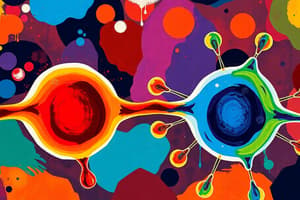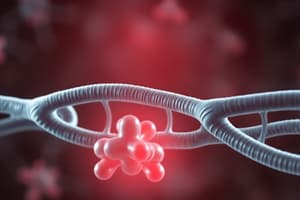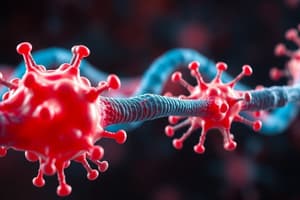Podcast
Questions and Answers
Which term describes the ability of a substance to produce maximal effects following receptor binding?
Which term describes the ability of a substance to produce maximal effects following receptor binding?
- Antagonist
- Partial Agonist
- Inverse Agonist
- Full Agonist (correct)
What term refers to the ability of a drug to bind to a receptor or target protein?
What term refers to the ability of a drug to bind to a receptor or target protein?
- Affiinity (correct)
- Efficacy
- Constitutional activity
- Intrinsic activity
Which of the following accurately describes a Partial Agonist?
Which of the following accurately describes a Partial Agonist?
- Produces some effects and inhibits others (correct)
- Inhibits all effects attributed to receptor interaction
- Produces maximal clinical effects
- Acts as an antagonist in all scenarios
What is the role of constitutional activity in drug-receptor interactions?
What is the role of constitutional activity in drug-receptor interactions?
Osmotic diuretics operate primarily through what mechanism?
Osmotic diuretics operate primarily through what mechanism?
What is the primary action of Aspirin in terms of platelet function?
What is the primary action of Aspirin in terms of platelet function?
Which condition is indicated for the use of Argatroban?
Which condition is indicated for the use of Argatroban?
What type of drugs are Clopidogrel and Prasugrel?
What type of drugs are Clopidogrel and Prasugrel?
Which of the following is NOT an antidote for warfarin toxicity?
Which of the following is NOT an antidote for warfarin toxicity?
What adverse effect is specifically associated with Lepirudin?
What adverse effect is specifically associated with Lepirudin?
What is the rationale for postponing surgery after the use of Aspirin?
What is the rationale for postponing surgery after the use of Aspirin?
Which factor may necessitate a review of warfarin dosage?
Which factor may necessitate a review of warfarin dosage?
What is the main mechanism of action for Direct Thrombin Inhibitors?
What is the main mechanism of action for Direct Thrombin Inhibitors?
What is the primary focus of pharmacodynamics in pharmacology?
What is the primary focus of pharmacodynamics in pharmacology?
Which classification of drugs is primarily used to supplement lacking endogenous substances?
Which classification of drugs is primarily used to supplement lacking endogenous substances?
What type of receptors are involved in signal transduction and are the most common in the study of pharmacology?
What type of receptors are involved in signal transduction and are the most common in the study of pharmacology?
What is the primary function of chemotherapeutic agents?
What is the primary function of chemotherapeutic agents?
What mechanism do ligand-gated receptors utilize to allow ion movement?
What mechanism do ligand-gated receptors utilize to allow ion movement?
Which of the following best describes pharmacokinetics?
Which of the following best describes pharmacokinetics?
What type of drug is Edrophonium primarily classified as?
What type of drug is Edrophonium primarily classified as?
Which type of receptors are known to exist as monomers and include kinases?
Which type of receptors are known to exist as monomers and include kinases?
Which classification of drugs includes analgesics and antipyretics?
Which classification of drugs includes analgesics and antipyretics?
What is a characteristic function of transporters in pharmacology?
What is a characteristic function of transporters in pharmacology?
What is the primary goal of the coagulation cascade during clot formation?
What is the primary goal of the coagulation cascade during clot formation?
Which factor is primarily targeted by indirect thrombin inhibitors such as heparin?
Which factor is primarily targeted by indirect thrombin inhibitors such as heparin?
What does Virchow's Triad include as one of the three factors contributing to clot formation?
What does Virchow's Triad include as one of the three factors contributing to clot formation?
Which of the following is a characteristic of low molecular weight heparins?
Which of the following is a characteristic of low molecular weight heparins?
What is a common side effect associated with the use of heparin?
What is a common side effect associated with the use of heparin?
What is the primary mechanism of action of coumarins like warfarin?
What is the primary mechanism of action of coumarins like warfarin?
Which anticoagulant is safe to use in pregnant patients?
Which anticoagulant is safe to use in pregnant patients?
The formation of which type of thrombus is primarily associated with arterial clots?
The formation of which type of thrombus is primarily associated with arterial clots?
What is the preferred route of administration for low molecular weight heparins?
What is the preferred route of administration for low molecular weight heparins?
Which of the following factors is NOT part of Virchow's Triad?
Which of the following factors is NOT part of Virchow's Triad?
What is the primary mechanism of action for HMG-CoA reductase inhibitors?
What is the primary mechanism of action for HMG-CoA reductase inhibitors?
Which agent is primarily used for the treatment of sizable pulmonary embolisms and acute ischemic strokes?
Which agent is primarily used for the treatment of sizable pulmonary embolisms and acute ischemic strokes?
Which of the following treatments is specifically indicated for managing hereditary bleeding disorders?
Which of the following treatments is specifically indicated for managing hereditary bleeding disorders?
What common side effect is associated with the use of fibrates?
What common side effect is associated with the use of fibrates?
What is the role of vitamin K in medical treatment?
What is the role of vitamin K in medical treatment?
Which of the following agents directly inhibits plasminogen conversion to plasmin?
Which of the following agents directly inhibits plasminogen conversion to plasmin?
What pharmacological action does cilostazol have?
What pharmacological action does cilostazol have?
Which of the following is NOT a criterion for therapeutic equivalence set by the FDA?
Which of the following is NOT a criterion for therapeutic equivalence set by the FDA?
Which of the following conditions would most likely require a combination of lipid-lowering agents?
Which of the following conditions would most likely require a combination of lipid-lowering agents?
In the context of anticoagulants, which agent is known to cause thrombocytopenia as an adverse effect?
In the context of anticoagulants, which agent is known to cause thrombocytopenia as an adverse effect?
What is the primary objective of drug distribution in the body?
What is the primary objective of drug distribution in the body?
Which drug is known to have high protein binding?
Which drug is known to have high protein binding?
What is the main application of vitamin B12 in treating anemias?
What is the main application of vitamin B12 in treating anemias?
What is the mechanism of action of niacin in lipid metabolism?
What is the mechanism of action of niacin in lipid metabolism?
What role does Phase I metabolism play in drug biotransformation?
What role does Phase I metabolism play in drug biotransformation?
In terms of enzyme activity, what is the consequence of genetic polymorphism?
In terms of enzyme activity, what is the consequence of genetic polymorphism?
Which of the following is an alternative to oral iron therapy for severe iron deficiency?
Which of the following is an alternative to oral iron therapy for severe iron deficiency?
Where does the majority of drug excretion occur in the body?
Where does the majority of drug excretion occur in the body?
How do phosphodiesterase (PDE) inhibitors aid in medical treatments?
How do phosphodiesterase (PDE) inhibitors aid in medical treatments?
Which lipid-lowering medication is known for having a high incidence of hepatotoxicity?
Which lipid-lowering medication is known for having a high incidence of hepatotoxicity?
What neurotransmitter is primarily released by postganglionic sympathetic neurons?
What neurotransmitter is primarily released by postganglionic sympathetic neurons?
Which of the following neurotransmitters is involved in the preganglionic sympathetic response?
Which of the following neurotransmitters is involved in the preganglionic sympathetic response?
Which of the following drugs is a natural catecholamine?
Which of the following drugs is a natural catecholamine?
What characterizes the sympathetic nervous system in terms of neuron arrangement?
What characterizes the sympathetic nervous system in terms of neuron arrangement?
What is the rate-limiting enzyme in the biosynthesis of catecholamines?
What is the rate-limiting enzyme in the biosynthesis of catecholamines?
Which of the following statements about drug metabolism is TRUE?
Which of the following statements about drug metabolism is TRUE?
Which part of the autonomic nervous system is responsible for controlling involuntary functions?
Which part of the autonomic nervous system is responsible for controlling involuntary functions?
What is a major feature distinguishing the parasympathetic nervous system's structure?
What is a major feature distinguishing the parasympathetic nervous system's structure?
Flashcards
Affinity
Affinity
The ability of a drug to bind to its specific target protein, like a receptor.
Intrinsic Activity
Intrinsic Activity
The ability of a drug to initiate a chain of events leading to a biological effect after it's bound to a receptor.
Full Agonist
Full Agonist
A drug that produces the maximum possible effect when binding to its receptor.
Partial Agonist
Partial Agonist
Signup and view all the flashcards
Antagonist
Antagonist
Signup and view all the flashcards
Pharmacology
Pharmacology
Signup and view all the flashcards
Drugs
Drugs
Signup and view all the flashcards
Diagnostic agents
Diagnostic agents
Signup and view all the flashcards
Replenishers
Replenishers
Signup and view all the flashcards
Functional modifiers
Functional modifiers
Signup and view all the flashcards
Chemotherapeutic agents
Chemotherapeutic agents
Signup and view all the flashcards
Pharmacodynamics (PD)
Pharmacodynamics (PD)
Signup and view all the flashcards
Pharmacokinetics (PK)
Pharmacokinetics (PK)
Signup and view all the flashcards
Receptors
Receptors
Signup and view all the flashcards
GPCR (G Protein-coupled Receptor)
GPCR (G Protein-coupled Receptor)
Signup and view all the flashcards
Vasospasm
Vasospasm
Signup and view all the flashcards
Platelet-Fibrin Plug
Platelet-Fibrin Plug
Signup and view all the flashcards
Coagulation Cascade
Coagulation Cascade
Signup and view all the flashcards
Virchow's Triad
Virchow's Triad
Signup and view all the flashcards
White Thrombi
White Thrombi
Signup and view all the flashcards
Red Thrombi
Red Thrombi
Signup and view all the flashcards
Foreign Body
Foreign Body
Signup and view all the flashcards
Indirect Thrombin Inhibitors
Indirect Thrombin Inhibitors
Signup and view all the flashcards
Heparin
Heparin
Signup and view all the flashcards
Low Molecular Weight Heparins (LMWH)
Low Molecular Weight Heparins (LMWH)
Signup and view all the flashcards
Warfarin
Warfarin
Signup and view all the flashcards
INR
INR
Signup and view all the flashcards
Vitamin K and Warfarin
Vitamin K and Warfarin
Signup and view all the flashcards
Heparin-induced Thrombocytopenia (HIT)
Heparin-induced Thrombocytopenia (HIT)
Signup and view all the flashcards
Aspirin
Aspirin
Signup and view all the flashcards
P2Y12 ADP Receptor Inhibitors
P2Y12 ADP Receptor Inhibitors
Signup and view all the flashcards
P2Y12 ADP Receptor Inhibitors - PCI
P2Y12 ADP Receptor Inhibitors - PCI
Signup and view all the flashcards
Therapeutic Equivalence
Therapeutic Equivalence
Signup and view all the flashcards
Drug Distribution
Drug Distribution
Signup and view all the flashcards
Protein Binding
Protein Binding
Signup and view all the flashcards
Volume of Distribution (Vd)
Volume of Distribution (Vd)
Signup and view all the flashcards
Drug Metabolism (Biotransformation)
Drug Metabolism (Biotransformation)
Signup and view all the flashcards
First Pass Effect/Metabolism
First Pass Effect/Metabolism
Signup and view all the flashcards
Phase I Metabolism
Phase I Metabolism
Signup and view all the flashcards
Phase II Metabolism (Conjugation)
Phase II Metabolism (Conjugation)
Signup and view all the flashcards
Prodrug, Active, and Toxic Metabolites
Prodrug, Active, and Toxic Metabolites
Signup and view all the flashcards
Enzyme Inhibition/Induction
Enzyme Inhibition/Induction
Signup and view all the flashcards
Genetic Polymorphism
Genetic Polymorphism
Signup and view all the flashcards
Drug Excretion
Drug Excretion
Signup and view all the flashcards
Autonomic Nervous System (ANS)
Autonomic Nervous System (ANS)
Signup and view all the flashcards
Efferent Neurons
Efferent Neurons
Signup and view all the flashcards
Synapse
Synapse
Signup and view all the flashcards
Antiplatelet
Antiplatelet
Signup and view all the flashcards
Antithrombotic
Antithrombotic
Signup and view all the flashcards
Thrombolytic
Thrombolytic
Signup and view all the flashcards
Prothrombotic
Prothrombotic
Signup and view all the flashcards
Vitamin K Deficiency
Vitamin K Deficiency
Signup and view all the flashcards
Antifibrinolytic
Antifibrinolytic
Signup and view all the flashcards
Dyslipidemia
Dyslipidemia
Signup and view all the flashcards
Lipid-Lowering Drug
Lipid-Lowering Drug
Signup and view all the flashcards
HMG-CoA Reductase Inhibitor
HMG-CoA Reductase Inhibitor
Signup and view all the flashcards
Fibrate
Fibrate
Signup and view all the flashcards
Bile Acid Sequestrant
Bile Acid Sequestrant
Signup and view all the flashcards
Sterol Absorption Inhibitor
Sterol Absorption Inhibitor
Signup and view all the flashcards
HDL-Raising Drug
HDL-Raising Drug
Signup and view all the flashcards
Anemia
Anemia
Signup and view all the flashcards
Hematopoietic Growth Factor
Hematopoietic Growth Factor
Signup and view all the flashcards
Study Notes
Pharmacology Study Notes
-
Definitions
- Pharmacology is the study of drugs.
- Drugs are used in diagnosis, prevention, treatment, and mitigation of diseases.
- Classification of Drugs includes:
- Diagnostic agents (e.g., Edrophonium for Myasthenia Gravis diagnosis)
- Radiopharmaceuticals (e.g., Technetium 99m sestamibi for MI)
- Replenishers (e.g., Cyanocobalamin for B12 deficiency)
- Functional Modifiers (e.g., analgesics, antipyretics)
- Chemotherapeutic Agents (e.g., anti-infectives, antineoplastics)
-
Branches of Pharmacology
- Pharmacodynamics (PD) focuses on what the drug does to the body.
- Pharmacodynamics studies drug effects in the body and mechanisms behind them.
- Pharmacokinetics (PK) focuses on what the body does to the drug.
- Pharmacokinetics studies drug movement in the body that reaches/leaves the site of action.
- Pharmacotherapeutics studies the rational use of drugs in disease management.
Pharmacodynamics
-
Drug Action Mechanisms
- Receptor-mediated action involves specific receptors.
- Receptors are cellular macromolecules or assemblies of macromolecules that facilitate chemical signaling between and within cells.
-
Types of Receptors
- G Protein-coupled Receptors (GPCRs) are 7-transmembrane spanning receptors; they involve signal transduction.
- Ion channels are regulated by membrane potential changes; they permit ion movement.
- Examples include voltage-gated Na+, K+, and Ca2+ channels.
- Ligand-gated receptors (ionotropic) alter gate configuration to allow ion passage, e.g., nicotinic and GABAa receptors.
- Kinase/Catalytic receptors exist as monomers and induce downstream signaling. Important for receptor binding site, kinase domain, and downstream molecules.
- Enzymes are targets; examples of drugs targeting enzymes such as ACE, COX and MAO.
- Transporters, or carriers, are responsible for movement of molecules across membranes (e.g., Na+/K+ ATPase).
Principles of Pharmacodynamics
- Protein Targets
- Drugs act on proteins
- Drug Targets
- Ligands, receptors; binding sites, kinase domain, downstream molecules
- Enzymes (ACE, COX, MAO).
- Transporters (Na+/K+ ATPase)
- Structural Proteins (e.g., tubulin)
- Other Mechanisms (Non-receptor-mediated)
- Direct chemical interaction (e.g., antacids)
- Colligative properties (osmotic diuretics)
- Counterfeit incorporation (analogs, e.g. 5-FU)
Drug-Receptor Interactions
-
Affinity - ability to bind to a receptor or target protein
-
Intrinsic Activity - ability to trigger a biochemical response
-
Constitutive Activity - ability to initiate a response even without a ligand
-
Orthosteric Site - primary binding site for endogenous ligands
-
Allosteric Site - secondary binding site, altering ligand binding and activity.
- Allosteric agonists enhance ligand binding; Allosteric antagonists inhibit ligand binding
-
Agonists, Inverse Agonists, and Antagonists
- Agonists stabilize the active receptor state
- Inverse agonists stabilize the inactive receptor state
- Antagonists maintain the equilibrium between inactive and active states
- Full agonists produce maximal clinical effects
- Partial agonists produce submaximal effects
- Antagonists prevent agonist binding without inducing a response
-
Clinical Antagonists
- drugs producing opposite effects of another drug or endogenous agonist.
Dose Response Relationship
- Hill Equation
- Relates drug concentration/dose to the resulting effect (E)
- Emax: maximal effect
- [A]50: concentration producing half-maximal effect
- nH: Hill coefficient (slope of the log-transformed curve)
- Dose Response Graph provides details on potency (dose generating 50% of effect) and efficacy (maximum achievable response).
Pharmacodynamics
-
Pharmacokinetic processes
- Absorption, distribution, metabolism, and excretion (ADME) -Transport Processes : Passive transport (diffusion, filtration) & Carrier-mediated transport (active and facilitated)
-
Fick's law describes rate of diffusion across membrane surfaces.
Studying That Suits You
Use AI to generate personalized quizzes and flashcards to suit your learning preferences.




